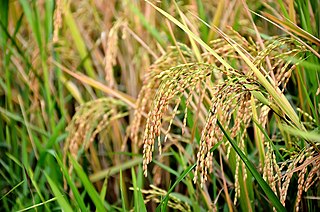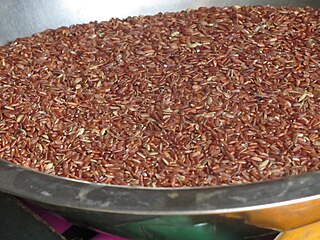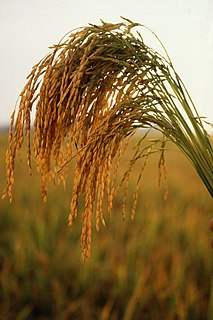Related Research Articles
Oryza is a genus of plants in the grass family. It includes the major food crop rice. Members of the genus grow as tall, wetland grasses, growing to 1–2 m tall; the genus includes both annual and perennial species.
Avena is a genus of Eurasian and African plants in the grass family. Collectively known as the oats, they include some species which have been cultivated for thousands of years as a food source for humans and livestock. They are widespread throughout Europe, Asia and northwest Africa. Several species have become naturalized in many parts of the world, and are regarded as invasive weeds where they compete with crop production. All oats have edible seeds, though they are small and hard to harvest in most species.

Oryza sativa, commonly known as Asian rice, is the plant species most commonly referred to in English as rice. It is the type of farmed rice whose cultivars are most common globally, and was first domesticated in the Yangtze River basin in China 13,500 to 8,200 years ago.

Red rice is a variety of rice that is colored red by its anthocyanin content. It is usually eaten unhulled or partially hulled, and has a red husk, rather than the more common brown. Red rice has a nutty flavor. Compared to polished rice, it has the highest nutritional value of rices eaten with the germ intact.. Some red rice has low glycemic index. This means that the rice will be slowly digested and energy will be slowly released. This will cause a slower increase in blood sugar levels. Red rice contains high antioxidant levels that reduce free radicals in the organism Besides, it is a rich source of iron, magnesium, calcium and zinc content than white rice.
Dan James Pantone is an American ecologist and conservationist with a Ph.D. from the University of California, Davis. A former professor at Texas A&M University, Dr. Pantone is a researcher who has published numerous refereed articles on agroecology and sustainable agriculture. In addition, he is a specialist in Geographical Information Systems (GIS) which he has used to help conserve endangered species. Dr. Pantone has established his broad experience in numerous scientific disciplines by publishing diverse articles ranging from the biological control of pests to the conservation biology of endangered species.

Intensive crop farming is a modern industrialized form of crop farming. Intensive crop farming's methods include innovation in agricultural machinery, farming methods, genetic engineering technology, techniques for achieving economies of scale in production, the creation of new markets for consumption, patent protection of genetic information, and global trade. These methods are widespread in developed nations.

Oryza rufipogon, known as brownbeard rice, wild rice, and red rice, is a member of the genus Oryza.

Oryza glaberrima, commonly known as African rice, is one of the two domesticated rice species. It was first domesticated and grown in West Africa around 3,000 years ago. In agriculture, it has largely been replaced by higher-yielding Asian rice, and the number of varieties grown is declining. It still persists, making up an estimated 20% of rice grown in West Africa. It is now rarely sold in West African markets, having been replaced by Asian strains.

Japonica rice, sometimes called sinica rice, is one of the two major domestic types of Asian rice varieties. Japonica rice is extensively cultivated and consumed in East Asia, whereas in most other regions indica rice is the dominant type of rice. Japonica rice originated from Central China, where it was first domesticated along the Yangtze River basin approximately 9,500 to 6,000 years ago.

Perennial rice are varieties of long-lived rice that are capable of regrowing season after season without reseeding; they are being developed by plant geneticists at several institutions. Although these varieties are genetically distinct and will be adapted for different climates and cropping systems, their lifespan is so different from other kinds of rice that they are collectively called perennial rice. Perennial rice—like many other perennial plants—can spread by horizontal stems below or just above the surface of the soil but they also reproduce sexually by producing flowers, pollen and seeds. As with any other grain crop, it is the seeds that are harvested and eaten by humans.

Genetically modified rice are rice strains that have been genetically modified. Rice plants have been modified to increase micronutrients such as vitamin A, accelerate photosynthesis, tolerate herbicides, resist pests, increase grain size, generate nutrients, flavours or produce human proteins.

Aeschynomene virginica is a rare species of flowering plant in the legume family known by the common names Virginia jointvetch and sensitive jointvetch. It is native to a small section of the East Coast of the United States, where it has a fluctuating annual global population scattered in about 20 mostly small occurrences. Counts and estimates revealed two populations in New Jersey including several thousand individuals, one population of a few hundred plants in Maryland, several variable and unstable populations in ditches in North Carolina, and several populations including about 5000 individuals in Virginia. Habitat alteration has reduced the number of sites where the plant can grow. The plant became a federally listed threatened species of the United States in 1992.

Plant breeding is the science of changing the traits of plants in order to produce desired characteristics. It has been used to improve the quality of nutrition in products for humans and animals. The goals of plant breeding are to produce crop varieties that boast unique and superior traits for a variety of agricultural applications. The most frequently addressed traits are those related to biotic and abiotic stress tolerance, grain or biomass yield, end-use quality characteristics such as taste or the concentrations of specific biological molecules and ease of processing.

Large scale rice production in the state of Arkansas became a significant industry in the late 19th/early 20th century with its wide scale propagation within the state by entrepreneur W.H. Fuller around 1896. Arkansas has historically been the largest rice producer in the entire United States, and accounted for nearly 45% of U.S. rice production in 2001, as well as just less than half of the total number of acres of rice harvested nationwide. Much of Arkansas' rice is grown in the east-central portion of the state, where it requires nearly three times more the amount of irrigation water than the average eleven inches the region receives during the growing season. In the areas of lowest precipitation, or where weedy red rice is a significant problem, farmers follow a three year, three phase "old rotation" of rice-soybean-soybean. However, most Arkansas rice producers follow a two year, two phase crop rotation of rice following soybeans.
Oryza punctata is an annual grass in the rice genus Oryza, also known as red rice, related to cultivated rice O. sativa. O. punctata forms clumps or tussocks from 50–120 cm tall. It is a native to tropical Africa and Madagascar but is also found in Thailand and other parts of Indochina. O. punctata is a weed species in commercial rice growing operations although it appears to be rare in its native range. O. punctata has an IUCN status of least concern. It is not generally eaten or used as fodder by farmers but there is some evidence that it has been used as such during periods of famine. Due to the importance of the crop varieties of rice globally, the evolution of the Oryza genus as a whole has been studied extensively. A lot of information about O. punctata has been elucidated as a secondary benefit to this commercial research. O. punctata evolved some 5 million years ago in the second of two rapid radiation events that occurred in the Oryza L. genus.

Bomba rice is a short-grain variety of rice, primarily cultivated in the eastern parts of Spain. It is commonly used in paella and other dishes in Valencian cuisine, and is often referred to as Valencia rice. It has short grains due to the presence of amylopectin.
Gandhakasala rice is a variety of rice cultivated by the farmers in Wayanad District in Kerala. This is a scented variety of rice grown mostly by the members of the tribal communities of in Panamaram, Sultan Bathery, and Mananthavady areas in Wayanad. As of 2010, gandhkasala is cultivated in an area of 327 hectares and jeerakasala in 22 hectares.
The history of rice cultivation is long and complicated. The current scientific consensus, based on archaeological and linguistic evidence, is that Oryza sativa rice was first domesticated in the Yangtze River basin in China 13,500 to 8,200 years ago. From that first cultivation, migration and trade spread rice around the world - first to much of east Asia, and then further abroad, and eventually to the Americas as part of the Columbian exchange. The now less common Oryza glaberrima rice was independently domesticated in Africa 3,000 to 3,500 years ago. Other wild rices have also been cultivated in different geographies, such as in the Americas.
The agricultural weed syndrome is the set of common traits which make a plant a successful agricultural weed. Most of these traits are not, themselves, phenotypes but are instead methods of rapid adaptation. So equipped, plants of various origins - invasives, natives, mildly successful marginal weeds of agriculture, weeds of other settings - accumulate other characteristics which allow them to compete in an environment with a high degree of human management.

Arroz de fríjol cabecita negra is a typical dish from the Caribbean Coast of Colombia, differing from rice dishes are usually prepared with different legumes such as lentils, Pigeon peas, and black-eyed peas.
References
- ↑ Parker, C. & Dean, M. L. 1976. Control of wild rice in rice. Pesticide Science 7: 403—416.
- ↑ Ferrero, A. & Finassi, A. 1995. Viability and soil distribution of red rice (Oryza sativa L. var. sylvatica) seeds. In Med. Fac. Landbouw., Rijksunv. Gent. pp. 205—211.
- 1 2 Plant biologist seeks molecular differences between rice and its mimic
- 1 2 Genetically Engineered Rice Varieties - What Issues Do They Raise?
- 1 2 Analysis of Uruguayan weedy rice genetic diversity using AFLP molecular markers
- ↑ FAO. 1999. Report of the Global workshop on red rice control. Varadero, Cuba, 30 August-3 September, pp. 55.
- ↑ Tarditi, N. & Vercesi, B. 1993. Il riso crodo: un problema sempre più attuale in risicoltura. L'Informatore Agrario 11: 91-95.
- ↑ A. Ferrero: Weedy rice, biological features and control
- ↑ De Souza, P. R. 1989. Arroz vermelho: um grande problema. Lavoura arrozeira 42: 30-31.
- ↑ Diallo, S. 1999. Problème posé par le riz rouge en riziculture au Sénégal. Report of the global workshop on red rice control, 30 August-3 September, Varadero, Cuba, 45-49.
- ↑ Garcia de la Osa, J. & Rivero, L. E. 1999. El arroz rojo. Estudios y perspectivas de su manejo en la produccion arrocera cubana. Report of the Global Workshop on Red Rice Control, 30 August-3 September, Varadero, Cuba. 25-31.
- ↑ Fletes, M. S. 1999. Evaluation de la maleza arroz rojo (Oryza sativa) en las principales zonas arroceras de Nicaragua. Report of the global workshop on red rice control. 30 August-3 September, Varadero, Cuba. 41-44.
